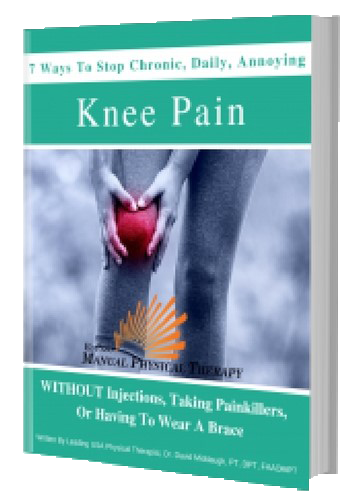TAP TO CALL (915) 503-1314

6 BEST TIPS TO HELP A LOOSE AND UNSTABLE KNEE REPLACEMENT WITHOUT SURGERY
Here are the six best tips to help a loose or unstable knee joint replacement without surgery. Number one is rest. Chances are if your knee replacement has become loose or unstable, you may be getting things like swelling and pain in your knee joint. It may not be very trustworthy for you, you may not want to step on it because it’s going to buckle or loosen up more whenever you get tired.
So you need to rest and make sure that that pain swelling and discomfort that you’re dealing with is going away. And this isn’t a rest for as long as possible. It’s a relative rest, which means you still need to use your leg, you still need to get up and go do things like go to the bathroom, cook yourself meals, take care of yourself. So do those things and make sure you have the right support like from a cane or a walker.
But also make sure that you’re not doing extra in order to try to help the knee you need to rest and let it recover. Number two is using a brace like this. This isn’t just a regular sleeve brace. This brace has brackets and hinges, that means that it’s got some stiff metal parts on the inside, they might be plastic in some braces as long as they’re durable.
And the hinges are really important because it guides the way that your knees posed to move. And I can’t take them out of this brace there’s sewn in. But there’s metal hinges that bend the brace a certain way.
Wearing a brace like this gives you extra support and stability to help that knee joint from wobbling and moving in ways that it shouldn’t so that it can heal so that the pain and swelling can calm down and put you in a position to fix a longer term problem. Number three is to stop walking for exercise.
A lot of people are told after they’ve had a knee replacement that you need to be walking, walking is good exercise for you. And although walking can be very good for you, it may not be good for you in certain situations like when your knee is unstable, or if it’s becoming loose because chances are there’s some unresolved problem that needs to be addressed before you can go start walking for exercise, confident that it’s going to be helping you rather than hurting you.
If you have a looser unstable knee joint right now, and you’ve had your knee replaced, of course, then walking might actually be making it worse and it’s going to be a good idea to stop and fix other problems first.
Number four is avoiding quadricep driven exercises. So the quadricep muscles are the muscles that are on the front of the thigh they come down from the front of the hip and the attached to the kneecap. And those muscles tend to be the most commonly used muscles when it comes to exercise.
This is why walking can be a problem. But if you’re doing other exercises like the bicycle, you’re doing any sort of weightlifting exercises, squats, any machines at the gym, especially the ones where you’re straightening out your knees, it’s commonly called the knee extension when you’re doing this, that exercise is all focused on getting the quad muscles stronger.
And the quad muscles are usually responsible for a muscle imbalance that ends up putting bad forces on the knee joint and can create shear forces, forces that are not normal for the knee joint. And that can be contributing to the parts loosening from their connection to the bone. And number five is related to this. If you can get your glute muscles stronger, those are the muscles on the backside of your hip.
They can counteract the effects of having over dominant, too strong quad muscles. So doing exercises that can engage and tire out the glute muscles on the back of the hip are going to be very productive, as long as you can do them without also tiring out your quad muscles in the front of your thighs a lot. One of the biggest mistakes that I see people do is they go do glute exercises, but they cannot shut off their quads when they’re doing glute exercises.
Now, I don’t mean completely shut off like get zero activity in the quads. What I mean is making sure that when you go do a dedicated glute exercise, that you can confidently say that you’re tiring on your glutes more than any other muscle, especially the muscles in your thighs. The number six kind of sums this all up fixing the muscle imbalances.
This process that I’ve described here, the quads being too strong and the glutes not being strong enough because you got to get them stronger is one of the muscle imbalances that can contribute to those shear force as I described at the knee joint.
There’s other muscle imbalances including some of the feet that commonly affect the forces at the knee joint and can contribute to having a loose or unstable knee joint. If you can correct these muscle imbalances.
It can make your knee replacement healthy for the long term and it’s even possible to improve it without ever having surgery and get it improved enough to where you feel confident to begin resuming walking for exercise to be able to go bicycling, to be able to enjoy time on your feet time with your friends and family time on vacations go sightseeing to do whatever you decide to do within reason comfortably without making your knee replacement worse over time.
If you’re looking for more help with knee replacements, I’ve got a whole playlist of knee replacement help videos it’s down In the description below the playlist is called Knee Replacement Pain Help. You’ll also find a link down there to a program that we have called the Failed Knee Replacement Recovery Program.
And that’s a comprehensive online program to help guide you through all the steps of fixing the muscle imbalance, as well as making sure that your knee replacement is healthy for the long term.
If you thought this video was helpful for you, please give us a thumbs up please share this with somebody you think needs to see this and don’t forget to subscribe and turn on our notification bell so that you don’t miss out on any of the helpful videos we post each and every week. Thanks so much for watching, and I’ll see you in the next video. Bye bye!
Would You Like To Talk With A Specialist?
Appointments and Questions Call: (915)503-1314
EL PASO MANUAL PHYSICAL THERAPY
2601 E. Yandell Drive, Suite 232
El Paso, Texas 79903
© 2023 El Paso Manual Physical Therapy, PLLC, All Rights Reserved
